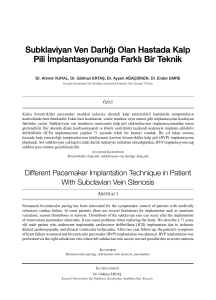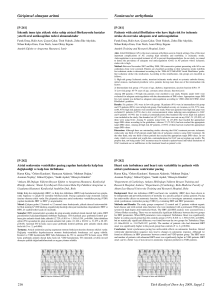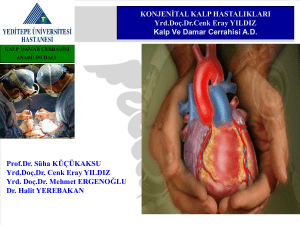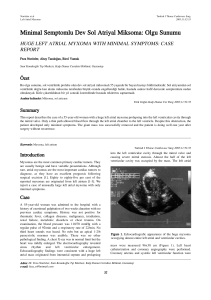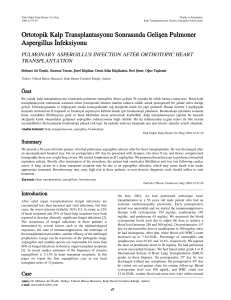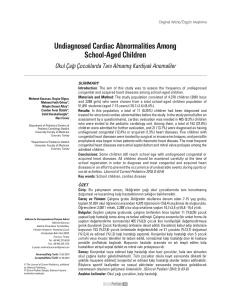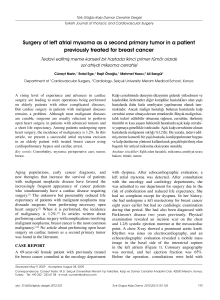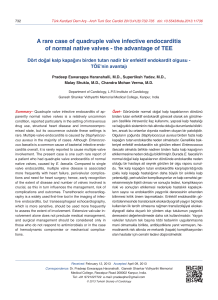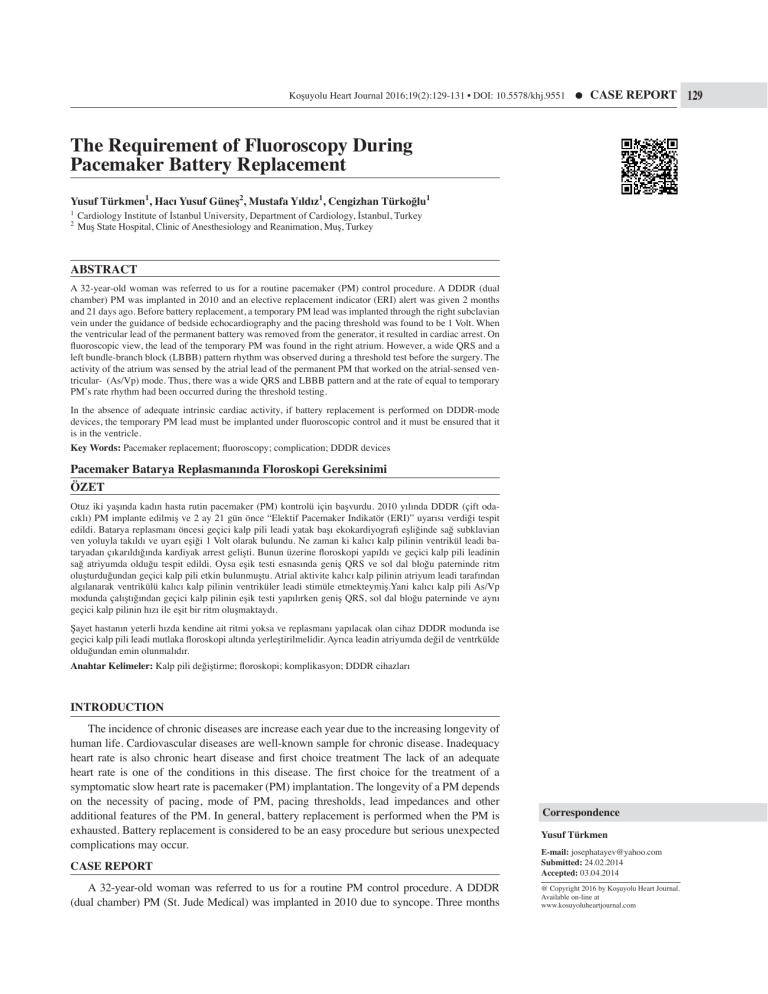
Koşuyolu Heart Journal 2016;19(2):129-131 • DOI: 10.5578/khj.9551 ●
CASE REPORT 129
The Requirement of Fluoroscopy During
Pacemaker Battery Replacement
Yusuf Türkmen1, Hacı Yusuf Güneş2, Mustafa Yıldız1, Cengizhan Türkoğlu1
1
2
Cardiology Institute of İstanbul University, Department of Cardiology, İstanbul, Turkey
Muş State Hospital, Clinic of Anesthesiology and Reanimation, Muş, Turkey
ABSTRACT
A 32-year-old woman was referred to us for a routine pacemaker (PM) control procedure. A DDDR (dual
chamber) PM was implanted in 2010 and an elective replacement indicator (ERI) alert was given 2 months
and 21 days ago. Before battery replacement, a temporary PM lead was implanted through the right subclavian
vein under the guidance of bedside echocardiography and the pacing threshold was found to be 1 Volt. When
the ventricular lead of the permanent battery was removed from the generator, it resulted in cardiac arrest. On
fluoroscopic view, the lead of the temporary PM was found in the right atrium. However, a wide QRS and a
left bundle-branch block (LBBB) pattern rhythm was observed during a threshold test before the surgery. The
activity of the atrium was sensed by the atrial lead of the permanent PM that worked on the atrial-sensed ventricular- (As/Vp) mode. Thus, there was a wide QRS and LBBB pattern and at the rate of equal to temporary
PM’s rate rhythm had been occurred during the threshold testing.
In the absence of adequate intrinsic cardiac activity, if battery replacement is performed on DDDR-mode
devices, the temporary PM lead must be implanted under fluoroscopic control and it must be ensured that it
is in the ventricle.
Key Words: Pacemaker replacement; fluoroscopy; complication; DDDR devices
Pacemaker Batarya Replasmanında Floroskopi Gereksinimi
ÖZET
Otuz iki yaşında kadın hasta rutin pacemaker (PM) kontrolü için başvurdu. 2010 yılında DDDR (çift odacıklı) PM implante edilmiş ve 2 ay 21 gün önce “Elektif Pacemaker Indikatör (ERI)” uyarısı verdiği tespit
edildi. Batarya replasmanı öncesi geçici kalp pili leadi yatak başı ekokardiyografi eşliğinde sağ subklavian
ven yoluyla takıldı ve uyarı eşiği 1 Volt olarak bulundu. Ne zaman ki kalıcı kalp pilinin ventrikül leadi bataryadan çıkarıldığında kardiyak arrest gelişti. Bunun üzerine floroskopi yapıldı ve geçici kalp pili leadinin
sağ atriyumda olduğu tespit edildi. Oysa eşik testi esnasında geniş QRS ve sol dal bloğu paterninde ritm
oluşturduğundan geçici kalp pili etkin bulunmuştu. Atrial aktivite kalıcı kalp pilinin atriyum leadi tarafından
algılanarak ventrikülü kalıcı kalp pilinin ventriküler leadi stimüle etmekteymiş.Yani kalıcı kalp pili As/Vp
modunda çalıştığından geçici kalp pilinin eşik testi yapılırken geniş QRS, sol dal bloğu paterninde ve aynı
geçici kalp pilinin hızı ile eşit bir ritm oluşmaktaydı.
Şayet hastanın yeterli hızda kendine ait ritmi yoksa ve replasmanı yapılacak olan cihaz DDDR modunda ise
geçici kalp pili leadi mutlaka floroskopi altında yerleştirilmelidir. Ayrıca leadin atriyumda değil de ventrkülde
olduğundan emin olunmalıdır.
Anahtar Kelimeler: Kalp pili değiştirme; floroskopi; komplikasyon; DDDR cihazları
INTRODUCTION
The incidence of chronic diseases are increase each year due to the increasing longevity of
human life. Cardiovascular diseases are well-known sample for chronic disease. Inadequacy
heart rate is also chronic heart disease and first choice treatment The lack of an adequate
heart rate is one of the conditions in this disease. The first choice for the treatment of a
symptomatic slow heart rate is pacemaker (PM) implantation. The longevity of a PM depends
on the necessity of pacing, mode of PM, pacing thresholds, lead impedances and other
additional features of the PM. In general, battery replacement is performed when the PM is
exhausted. Battery replacement is considered to be an easy procedure but serious unexpected
complications may occur.
CASE REPORT
A 32-year-old woman was referred to us for a routine PM control procedure. A DDDR
(dual chamber) PM (St. Jude Medical) was implanted in 2010 due to syncope. Three months
Correspondence
Yusuf Türkmen
E-mail: [email protected]
Submitted: 24.02.2014
Accepted: 03.04.2014
@ Copyright 2016 by Koşuyolu Heart Journal.
Available on-line at
www.kosuyoluheartjournal.com
130
Koşuyolu Heart Journal 2016;19(2):129-131 ●
Fluoroscopy and temporary pacemaker implantation
removed, it resulted in cardiac arrest. Subsequently, fluoroscopy
was performed with anteroposterior (AP) projection and an image
was obtained, as shown in Figure 1. As seen in Figure 1, she had
a really large right atrium and the lead of the temporary PM was
found in the right atrium instead of the right ventricle, and it had
been pacing the right atrium during the threshold testing before
the operation. Then the activity of the atrium was sensed by the
atrial lead of the permanent PM that worked on the atrial-sensed
ventricular-paced (As/Vp) mode. Thus, there was a wide QRS
and left bundle-branch block (LBBB) pattern and at the rate of
equal to temporary PM’s rate rhythm had been occurred. In other
words, the rhythm with wide QRS complex and LBBB pattern
did not occur by a direct stimulation of the temporary PM but as a
result of the As/Vp function of the permanent PM.
After the fluoroscopy, the lead of the temporary PM was
placed in the right ventricle and the replacement of the battery
was performed successfully.
DISCUSSION
Figure 1. Anteroposterior fluoroscopic view of temporary and permanent pacemaker leads.
after the implantation, the atrial lead was dislocated and a
repositioning operation was performed but the atrial lead could
not be implanted at the desired location. Therefore, the threshold
of the atrial lead was 2.4 Volt with 0.8 millisecond pulse width.
Accordingly, the PM exhausted earlier than expected. There
was no additional known disease. On physical examination, the
patient had a temperature of 36.6°C, blood pressure of 90/55
mmHg, pulse of 80 bpm and respiratory rate of 14 breaths/min.
There was a scar in the left infraclavicular area at the point where
her PM was implanted. On PM analysis, an elective replacement
indicator (ERI) alert was given 2 months and 21 days ago. The
pacing rate of the PM was reduced to 30 bpm but no intrinsic
activity was recorded. The patient was hospitalised due to sudden
failure of PM functions and the absence of adequate intrinsic
heart rate. Before battery replacement, a temporary PM lead was
implanted through the right subclavian vein under the guidance of
bedside echocardiography by a different team of physicians. The
temporary PM was tested at the rate of 100 bpm and the threshold
was found to be 1 Volt. Thereby, no additional imaging technique
was required to determine the location of the temporary PM lead.
Later, the temporary PM was adjusted to 100 stimulations/min
and 5 Volt output, and the operation of the permanent battery
replacement was initiated without fluoroscopic control. When the
ventricular lead of the permanent battery was removed from the
generator, it resulted in cardiac arrest. The lead was reconnected
to the battery immediately, and the old rhythm was maintained
again with wide QRS and a rate of 100 bpm. Later, the rate of the
temporary PM was increased to 120 stimulations/min and wide
QRS rhythm was observed; accordingly, a rate of 120 simulations/
min suggested appropriate functioning of the temporary PM.
However, when the ventricular lead of the permanent battery was
The main reason for PM replacement is battery exhaustion(1).
Battery replacement operations are considered to be easy
procedures but unexpected serious complications may occur.
When a lead of a permanent PM is cut accidentally during battery
replacement in the absence of patient’s intrinsic activity and a
temporary PM, serious consequences may arise. Further, the
infection rate is also found to be higher in replacement procedures
than in initial implantation. The underlying causes of this are
insufficiency of natural protective mechanisms, such as the
disturbance of tissue integrity and poor blood circulation in the
battery pocket. Another complication reported by Kolb C. et al.
is the development of a ventricular tachycardia storm during an
implantable cardioverter defibrillator (ICD) battery replacement
operation; they suggested a ventricular tachycardia stimulation
procedure before ICD battery replacement in high-risk patients(2).
During ICD battery replacement, if there was a cross-talk between
the defibrillation lead and the lead of the temporary PM, an ICD
could not deliver a shock therapy in the course of defibrillation
threshold testing (DFT) and external defibrillation was required(3).
The first incorrect approach in our case was the implantation of a
temporary PM lead without fluoroscopic control. If the battery of
the PM was exhausted, the patient would have developed cardiac
arrest due to the absence of her intrinsic cardiac activity. The
second incorrect approach was to not use fluoroscopy before the
replacement surgery. If the PM was in a VVI (single chamber)
and not DDDR mode and the temporary PM was found to be
effective during threshold testing, the replacement operation
could be performed without fluoroscopic control. However, we
cannot be sure of the location of the temporary PM lead based on
its stimulation response owing to the As/Vp function of DDDR
PMs. Thus, in our case, the lead of the temporary PM had moved
to the right atrium and it stimulated the atriums first. Then the
atrial activity was sensed by the atrial lead of the permanent PM
and the ventricle was stimulated via the ventricular lead of the
Türkmen Y, Güneş HY, Yıldız M, Türkoğlu C.
● Koşuyolu Heart Journal 2016;19(2):129-131
permanent PM as a result of the As/Vp mode of DDDR PM. The
heart rate was also equal to the temporary PM’s stimulation rate.
Therefore, it was assumed that the ventricle was stimulated by the
lead of the temporary PM.
REFERENCES
1.
Liu XL, Ren LH, Ye HM. Reasons and complications of pacemaker
replacement operation: clinical analysis of 69 case-times. Zhonghua Yi Xue
Za Zhi 2008;88:1989-91.
If there had been adequate intrinsic cardiac activity, the
replacement surgery could have been performed without
fluoroscopic control.
2.
Kolb C, Zrenner B, Schmitt C. Near-fatal incident on routine induction of
ventricular fibrillation at the replacement of an implantable cardioverter
defibrillator. Int J Cardiol 2006;112:e74-5.
3.
Jimenez A, Dickfeld T, Saliaris A, Shorofsky S. Pacemaker/implantable
cardioverter-defibrillator interaction. Heart Rhytm 2010;7:1157-60.
CONCLUSION
In the absence of adequate intrinsic cardiac activity, if battery
replacement has to be performed on DDDR-mode devices,
the temporary PM lead must be implanted under fluoroscopic
control and it must be ensured that it is appropriately placed in
the ventricle.
131

